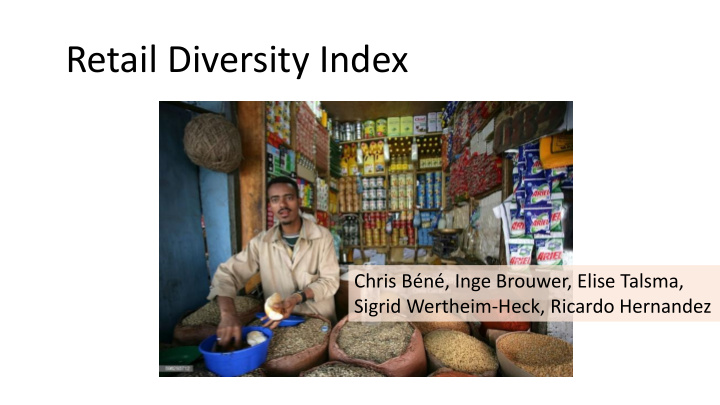



Retail Diversity Index Chris Béné, Inge Brouwer, Elise Talsma, Sigrid Wertheim-Heck, Ricardo Hernandez
Some definitions… Food retail encompasses all food sold to consumers for preparation and consumption at home as well as the final preparation of food for consumption away from home. Food retailers : restaurants, groceries, convenient stores, supermarkets, street vendors, etc. => retail is thus a great part of the Food Environment and influences consumers’ choice of food
Assumptions: May 2012 ▪ The type of food retailers we have “around” us Where fresh foods are scarce, so is good health strongly influences what we buy and/or what we eat (in the streets or at home) ▪ The more “healthy” the food sold by those retailers, the healthier our diet ▪ (alternatively) the less “healthy” the food sold by those retailers, the less healthier our diet e.g. the “food deserts” in US
Proposition (two steps) 1. Develop a Retail Diversity Index that capture the “diversity” of the food available through food retail sources (methodology) 2. Test some of those assumptions in the cases of low- middle-income countries (empirical analysis)
Step 1 : developing a Retail Diversity Index From literature – measures of actual food and beverage products provide a better indicator of the local food environment and decision of people than just the spatial availability of food outlets alone (Farley and Rice et al.(2009) and others ) For our RDI it means we will look at (i) community nutrition environment e.g. number, type, location and spatial accessibility of food outlets that are available to the general population (ii)consumer nutrition environment , including the availability, type of food and beverage products
Step 1 : developing a Retail Diversity Index On the community nutrition environment , couples of remarks: (i) conclusion from the literature: To get number, type, location and accessibility of food outlets = better to do a on-the-ground survey (direct observation) than relying on SIC code of some sort (ii)RDI should satisfy logistic/operational constraints (easy/quick to be collected) and analytical objective = capture some important potential explanatory dimensions related to choice of consumers
Step 1 : developing a Retail Diversity Index On the consumer nutrition environment , couples of remarks: (i) Generally diet quality in developing countries has been assessed using a range of dietary diversity scores DDS or food variety scores DDS = calculated by summing the number of food groups consumed during last 24 hour (e.g. Krebs-Smith et al. 1987). Food groups : e.g. cereals/roots, vegetables, fruits, legumes/lentils, meat/fish/egg & milk/dairy products. We should go for a RDI of the same nature than was done at the consumer level
Step 1 : developing a Retail Diversity Index On the consumer nutrition environment , couples of remarks: (ii) Typical food items that have been used in surveys include: fruit, vegetables, milk, meat and alternatives, (iii) But also a range of less healthy items, such as sugary beverages, salty snacks and confectionery. We should also include some information about unhealthy foods in our index
Step 1 : developing a Retail Diversity Index Junk food index JFI based on energy dense foods and beverages (EDNP) including • Fried potato products • Other salty or sweet chips • Hot snacks (crockets, pizzas, etc.) • Cakes, pastries • Energy dense products, e.g bars • Burgers, Hotdogs • Sweetened beverages (Coke, Pepsi, etc.) • Sugary or high energy drinks (Redbull, etc.)
Step 1 : developing a Retail Diversity Index Advantages of this approach similar nature than DDS = to be able to compare with the results obtained at the household level (linked to 24 recall data) to be able to compare the diversity between groups of different shop (supermarket, convenience stores, mom-and-pop, etc.) to see if this different level of diet diversity translate into dietary diversity at household level.
Step 2 : testing the RDI in the field • Take a picture of the outlet visited from outside • Visually determine the type of outlet: 1. Ambulant Street vendor 2. Open-air / sidewalk informal food stall/catering 3. Street / sidewalk catering / restaurant 4. Mom-&-Pop / small traditional family-owned grocery store 5. Formal wet-market 6. Informal (wet) market 7. Small or medium size “modern” restaurant / catering 8. Chain-based micro/minimarket 9. Larger supermarket 10. Convenient store
Step 2 : testing the RDI in the field Currently being tested in Vietnam (Hanoi) Ambition: Nigeria (Ibadan)
Step 2 : testing the RDI in the field
Step 2 : testing the RDI in the field
Step 2 : testing the RDI in the field
Step 2 : testing the RDI in the field
Step 2 : testing the RDI in the field
Step 2 : testing the RDI in the field • Take a picture of the outlet visited from outside • Visually determine the type of outlet • Visual inventory of outlet: • Enter the outlet • Record the different types of items that are on sell. • as you see them on display while walking slowly along the different sections/shelfs of the store. • determine what sort of items are proposed by reviewing the menus displayed in the premises. (Street / sidewalk catering / restaurant and Small or medium size “modern” restaurant / catering) • identify visually the items from a close distance or (if they are willing to answer) ask the person. (Ambulant street vendor or Open-air / sidewalk informal food caterer)
Food groupings used 1. Unprocessed/fresh or cooked/boiled starchy staples 2. Unprocessed/fresh or cooked legumes and nuts 3. Dairy products (fresh and/or processed) 4. Other animal source foods 5. Vitamin A-rich dark green leafy vegetables (unprocessed/fresh or cooked/boiled) 6. Other vitamin A-rich vegetables and fruits (unprocessed/fresh or cooked/boiled) 7. Other vegetables or fruits (unprocessed/fresh or cooked/boiled) 8. Ready-to-eat dishes and meals (fresh or cooked) 9. Junk foods 10.Drinks and beverages
Results are forthcoming.......
Recommend
More recommend